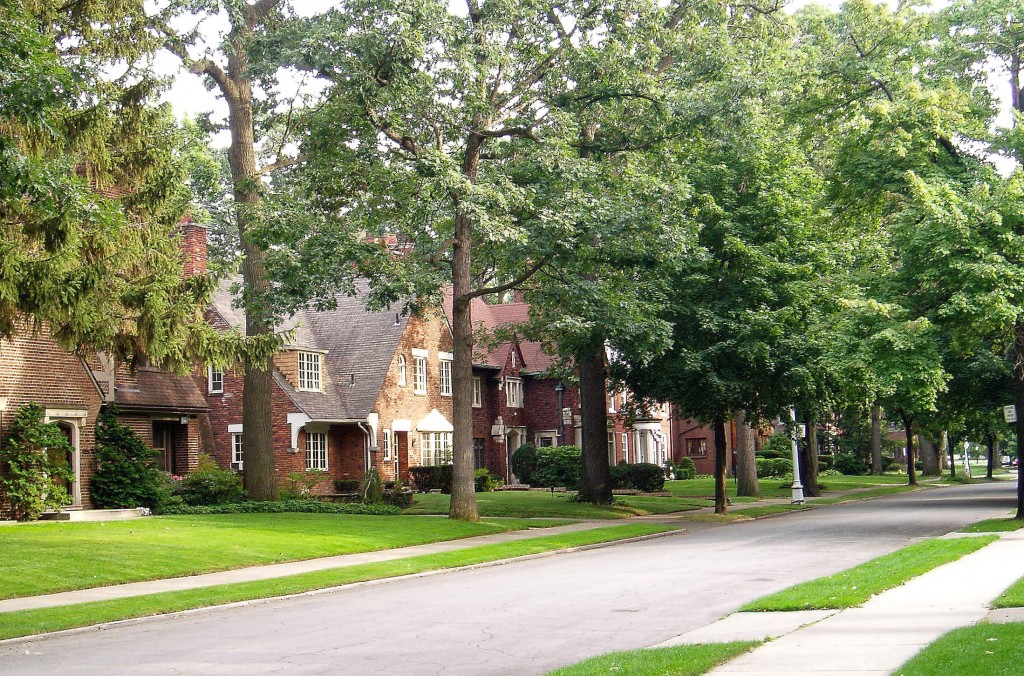
One of the unfortuneate consequences of the fight against urban sprawl, which has been largely taken up in the name of Jane Jacobs, is the loss of green space and the urban forests of many communities. They are disappearing in the manner environmentalists call ‘death by a thousand cuts’, that is (sometimes) slowly and incrementally.
Sherwood Forest is one of the old, upscale, districts of Detroit, ‘the city of Neighbourhoods’;
“Developers thought that the area should resemble an English village; thus, they selected appropriate English names and curved and winding streets. You will not find a rectangular street pattern here or in old English villages. There are about 435 homes, most of them built before the Depression terminated housing construction in the city. Many of them are Georgian Colonials or English Tudor homes in keeping with the English theme. Some of the homes are newer, having been constructed after building resumed in 1947. They are large, even by the standards of early 21st-century architecture since they average about 3,600 square feet with four to six bedrooms.”
In the adjacent suburb of Palmer Woods is the Dorothy Turkel House by Frank Lloyd Wright, which undoubtably also relies on its leafy surrounds for its ambience.
British biologist Professor Jeff Sayer in his lecture at James Cook University asked the apt conservation question, ‘Conserving the forests for whom?’

As this urban centred debate continues the world of microbial ecology is adding new knowledge of the carbon cycle and to the carbon accounting equation of rainforest ecologies…
[ http://www.scienceinpublic.com/stories/2010/forest-sink/ ] and potentially old growth temperate forests. [ http://www.theage.com.au/opinion/preserving-oldgrowth-forests-is-vital-to-saving-the-planet-20090621-cshx.html ]
Difficult to overestimate the psychological value of growing up in that street compared to the mean and nasty little collections of private spaces which are being designed now!
Best
Robert
If you had set Sherwood Forest,Detroit, as a guessing game I might have made 1m other guesses before I got it right. But despite its English character, the front gardens without fences or walls should have told me that it was not in England. So I should have been going through all the large settlements on the East Coast of the US. My criticism of housing reformers is that they all offer us panaceas – and what consumers want is a vast range of choice. I don’t know what China is going to do when apartment living becomes less popular.
This scene in Detroit could indeed be on the East Coast in America as well. Ohio writer Frank Scott is his book of 1870, The Art of Beautifying Home Grounds, recommended that the lawn of one house sweep into the lawn of the next. Certainly happens in this picture. Scott wrote that Andrew Jackson Downing his inspiration for his treatment of the landscape. Downing, of course, preferred all things English in landscape and garden, and recognized J. C. Loudon as his mentor.
Yes. Sharing a front lawn is one form of communal living. It takes a commitment from each person in the neighbourhood to upkeep their patch of lawn to create the tranquil sweeping feeling of a lawned street.
ps. Thankyou to the reference by Scott he recommends (p110):
“no lawn can be bought to perfection if it is cut less often than once a week, and two weeks is the longest time a lawn should remain uncut, except in periods of total suspension of growth by severe drought.”
You sometimes see shared front lawns in England but I think the idea always comes from the land owner/developer and I doubt if it is ever what the residents want. ‘My home is my castle’ is a fair summary of the English attitude – and probably derives from the time (most of history, in fact) when gardens were places to grow food. Loudon did much to popularise the idea of a garden as a place for horticultural display, rather than food production. It is also likely that the coal smoke in industrial cities made food production problematic.
These examples in Chicago demonstrate that the shared lawn wasn’t everyone’s cup of tea, notice the attempts to fence individual patches of green.
[ http://achicagosojourn.blogspot.com/2010/06/new-incomparable-striking-in-every.html ]